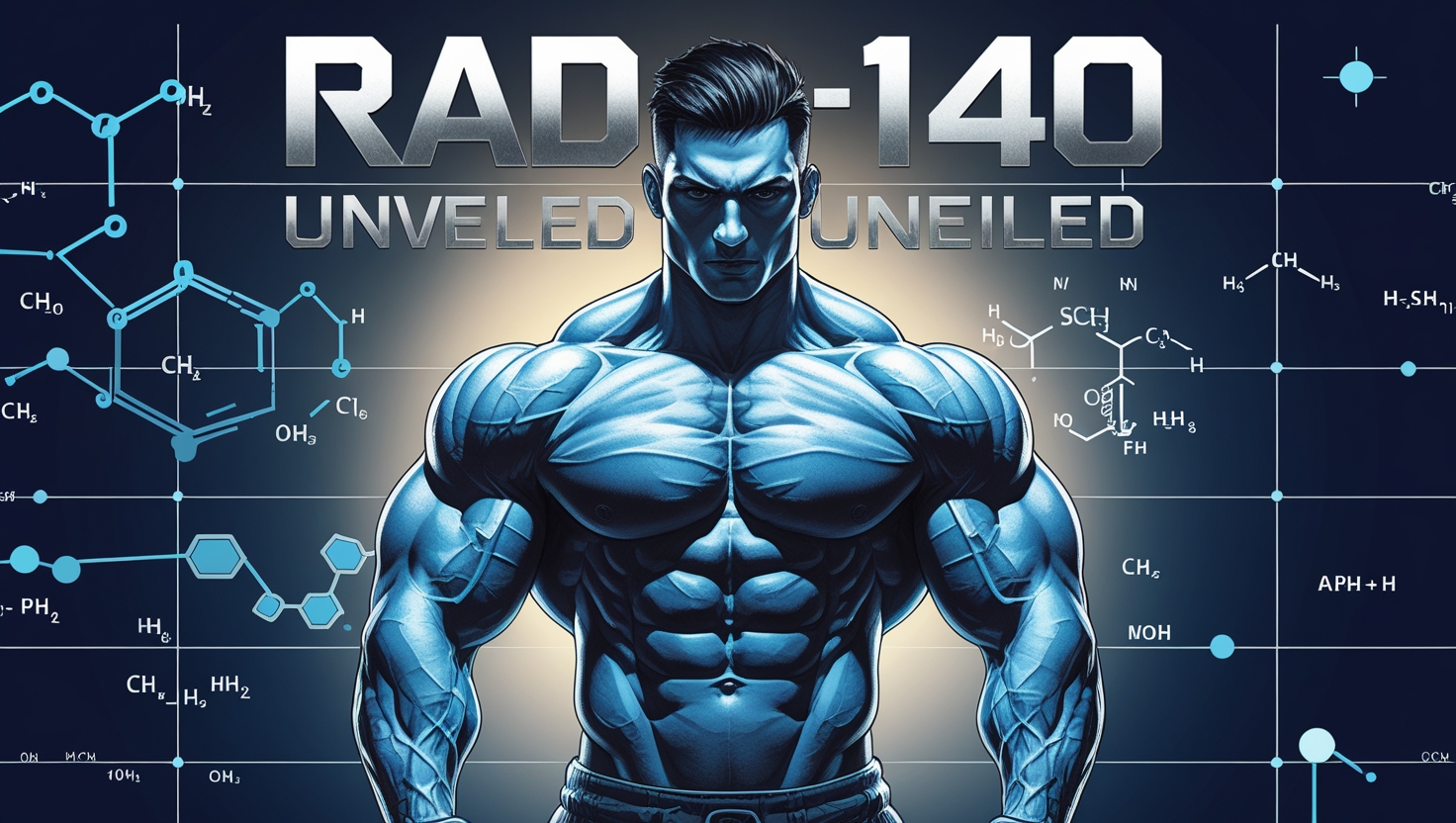sports

May 22,2025 • 7 min read
RAD-140 Unveiled: Benefits, Side Effects, and Applications for Muscle Growth

RAD-140 and Its Muscle-Building Potential
RAD-140, commonly referred to as Testolone, is a selective androgen receptor modulator (SARM) engineered to target androgen receptors in muscle and bone tissues, offering anabolic effects without the widespread systemic impact of traditional steroids. Its ability to promote muscle hypertrophy and enhance strength has made it a focal point in both medical research and fitness communities, particularly for those seeking Rad 140 for sale. We explore its mechanisms, benefits for muscle growth, potential side effects, and considerations for safe use, drawing on preclinical and clinical data to provide a comprehensive overview.
How RAD-140 Drives Muscle Growth
Mechanism of Action for Anabolic Effects
RAD-140 binds to androgen receptors with a high affinity (Ki of 7 nM), surpassing testosterone (29 nM) and rivaling dihydrotestosterone (10 nM). This selective binding triggers anabolic pathways, increasing protein synthesis and muscle cell growth. In preclinical studies on rats, RAD-140 at doses as low as 0.03 mg/kg increased levator ani muscle weight by 20–30%, matching testosterone’s efficacy at 0.3 mg/kg without significant prostate enlargement. This tissue selectivity makes RAD-140 appealing for bodybuilders monitoring SARMs before and after results, as it minimizes androgenic side effects like hair loss or prostate hypertrophy.
Hormonal Modulation and Muscle Synthesis
RAD-140 influences muscle growth by upregulating androgen receptor activity in skeletal muscle, enhancing nitrogen retention and protein accretion. In castrated rats, doses of 0.1–1 mg/kg restored muscle mass to levels comparable to intact controls, indicating robust anabolic potential. Unlike steroids, RAD-140 does not aromatize into estrogen, reducing risks of water retention or estrogen-driven side effects. However, it suppresses endogenous testosterone production, with studies in cynomolgus monkeys showing a 50% reduction in testosterone levels (from 600–800 ng/dL to 200–300 ng/dL) at 0.1 mg/kg, necessitating post-cycle therapy (PCT) to restore hormonal balance.
Benefits of RAD-140 for Muscle Growth and Beyond
Enhanced Muscle Hypertrophy and Strength
RAD-140’s primary appeal lies in its ability to accelerate muscle growth and strength gains. In preclinical models, it increased muscle fiber cross-sectional area by 15–25% in rats at 0.3 mg/kg, outperforming other SARMs like Ostarine in anabolic potency. Human anecdotal reports suggest gains of 5–15 pounds of lean muscle over an 8-week cycle at 10–20 mg/day, though individual results vary based on diet, training, and genetics. Its ability to enhance endurance and recovery further supports intense training regimens, making it a staple in bodybuilding protocols.
Bone Health and Medical Applications
Beyond muscle growth, RAD-140 shows promise in treating conditions like osteoporosis and sarcopenia. In androgen-deficient rats, it increased bone mineral density by 10–15% at 0.3 mg/kg, supporting osteoblast activity without stimulating prostate tissue. These findings position RAD-140 as a potential therapy for age-related muscle and bone loss, particularly in populations with declining androgen levels. Its neuroprotective effects, observed in rat models of Alzheimer’s disease, also suggest benefits for cognitive health, potentially by modulating androgen pathways in the brain.
Side Effects and Risks of RAD-140
Hormonal Suppression and Recovery
RAD-140’s suppression of the hypothalamic-pituitary-gonadal (HPG) axis is a significant concern. Studies in male rats at 1 mg/kg daily for two weeks showed reductions in luteinizing hormone (LH) and follicle-stimulating hormone (FSH) by 40–60%, alongside testosterone suppression. In humans, this can manifest as low energy, reduced libido, and mood changes post-cycle. A 4–6-week PCT regimen with selective estrogen receptor modulators (SERMs) like Clomiphene (25–50 mg/day) or Tamoxifen (20 mg/day) is critical to restore HPG axis function and prevent prolonged hypogonadism.
Liver Toxicity and Metabolic Effects
Case reports highlight RAD-140’s potential for hepatotoxicity. A 22-year-old male developed drug-induced liver injury after 16 weeks of use, with elevated aspartate aminotransferase (AST) and alanine aminotransferase (ALT) levels (3–5 times the upper limit of normal). Clinical trials in breast cancer patients reported elevated liver enzymes in 59.1% (AST) and 45.5% (ALT) of participants at 50–150 mg/day. Additionally, RAD-140 alters lipid profiles, with cynomolgus monkey studies showing increased LDL cholesterol and decreased HDL cholesterol, raising cardiovascular concerns that warrant monitoring.
Other Reported Side Effects
While RAD-140 avoids aromatization, some users report gynecomastia in approximately 10–15% of cases, likely due to testosterone suppression creating a relative estrogen dominance. Other side effects include nausea, fatigue, and headaches, observed in 20–30% of clinical trial participants. Long-term use may exacerbate these risks, particularly in unregulated settings where product purity is uncertain.
Practical Applications of RAD-140 in Bodybuilding
Dosing and Cycle Guidelines
For muscle growth, RAD-140 is typically dosed at 10–20 mg/day for men and 5–10 mg/day for women, cycled for 6–8 weeks to balance efficacy and safety. Higher doses (e.g., 30 mg/day) increase risks of side effects without proportional benefits. Users should split doses to maintain stable blood levels, given RAD-140’s half-life of approximately 60 hours. Combining RAD-140 with a high-protein diet (1.6–2.2 g/kg body weight) and resistance training maximizes muscle gains, with studies suggesting a 20–30% increase in strength metrics like one-rep max bench press.
Post-Cycle Therapy and Monitoring
Post-cycle therapy is non-negotiable to counteract testosterone suppression. Blood work before, during, and after cycles should monitor testosterone, LH, FSH, SHBG, and liver enzymes. Baseline testosterone levels in healthy males (300–1000 ng/dL) can drop to hypogonadal ranges (<200 ng/dL) during a cycle, necessitating PCT to restore levels within 4–8 weeks. Regular lipid panels are also recommended to track cholesterol changes, particularly given RAD-140’s impact on LDL and HDL.
Safety Considerations and Sourcing
RAD-140 is not FDA-approved for human use, and its availability through unregulated markets poses risks of contamination or mislabeling. Third-party testing of products is essential to ensure purity, as contaminated SARMs have been linked to adverse effects like heavy metal toxicity. Consulting a healthcare provider before use, especially for individuals with liver, cardiovascular, or hormonal conditions, is critical. Users should also avoid combining RAD-140 with other hepatotoxic substances, such as alcohol or certain supplements, to reduce strain on the liver.
RAD-140 in Medical Research
Therapeutic Potential for Muscle Wasting
RAD-140’s anabolic effects make it a candidate for treating muscle-wasting conditions like cachexia, common in cancer or chronic illness. In rat models, it prevented muscle loss in androgen-deficient states, increasing lean mass by 15–20% at 0.3 mg/kg. Its bone-sparing effects further support its use in sarcopenia, where muscle and bone loss coexist. These applications could benefit aging populations or patients undergoing treatments like chemotherapy, which suppress androgens.
Neuroprotective and Cognitive Benefits
In kainate-lesioned rat models, RAD-140 reduced neuronal death and amyloid beta plaques, suggesting neuroprotective potential. These effects may translate to human applications, particularly for neurodegenerative diseases like Alzheimer’s, where androgen receptor activation in the hippocampus supports cognitive function. Such findings highlight RAD-140’s versatility beyond bodybuilding, though clinical trials are needed to confirm efficacy in humans.
Conclusion
RAD-140 (Testolone) offers significant potential for muscle growth, bone health, and neuroprotection, driven by its selective androgen receptor binding and potent anabolic effects. Its ability to enhance lean mass and strength without the side effects of steroids makes it appealing for bodybuilding and medical applications. However, risks like testosterone suppression, liver toxicity, and lipid profile changes demand careful management, including proper dosing, PCT, and regular monitoring. By leveraging research-backed insights and prioritizing safety, users can maximize RAD-140’s benefits while minimizing its risks.
David Harris Details
User Profile
- Full name
- David Harris
- Email address
- aadamssmith957@gmail.com
- Join Date
- 2025-05-22
- State
- City
- Pincode
- Address
- Follow us on Facebook
- Follow us on Twitter
- Website Name
- Bio